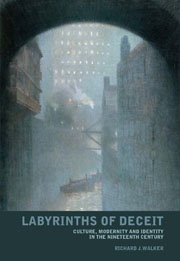Book contents
- Frontmatter
- Contents
- Acknowledgements
- Introduction: Tracing the fragments of modernity
- Part I (De)Generating doubles: duality and the split personality in the prose writing of James Hogg, Robert Louis Stevenson and Oscar Wilde
- Part II The stripping of the halo: religion and identity in the poetry of Alfred Tennyson, James ‘B. V.’ Thomson and Gerard Manley Hopkins
- Part III Infected ecstasy: addiction and modernity in the work of Thomas De Quincey, Alfred Tennyson, Christina Rossetti and Bram Stoker
- Introduction
- 8 A change in physical economy: Thomas De Quincey's confession
- 9 Coming like ghosts to trouble joy: Alfred Tennyson's ‘The Lotos Eaters’
- 10 Like honey to the throat but poison to the blood: Christina Rossetti's addictive market
- 11 The blood is the life: Bram Stoker's infected capital
- Conclusion: Ghost-script
- Notes
- Bibliography
- Index
8 - A change in physical economy: Thomas De Quincey's confession
from Part III - Infected ecstasy: addiction and modernity in the work of Thomas De Quincey, Alfred Tennyson, Christina Rossetti and Bram Stoker
- Frontmatter
- Contents
- Acknowledgements
- Introduction: Tracing the fragments of modernity
- Part I (De)Generating doubles: duality and the split personality in the prose writing of James Hogg, Robert Louis Stevenson and Oscar Wilde
- Part II The stripping of the halo: religion and identity in the poetry of Alfred Tennyson, James ‘B. V.’ Thomson and Gerard Manley Hopkins
- Part III Infected ecstasy: addiction and modernity in the work of Thomas De Quincey, Alfred Tennyson, Christina Rossetti and Bram Stoker
- Introduction
- 8 A change in physical economy: Thomas De Quincey's confession
- 9 Coming like ghosts to trouble joy: Alfred Tennyson's ‘The Lotos Eaters’
- 10 Like honey to the throat but poison to the blood: Christina Rossetti's addictive market
- 11 The blood is the life: Bram Stoker's infected capital
- Conclusion: Ghost-script
- Notes
- Bibliography
- Index
Summary
Whether desperate or not, however, the issue of the struggle in 1813 was what I have mentioned; and from this date, the reader is to consider me as a regular and confirmed opium-eater, of whom to ask whether on any particular day he had or had not taken opium, would be to ask whether his lungs had performed respiration, or the heart fulfilled its functions.
In his singular account of addiction, Confessions of an English Opium Eater, Thomas De Quincey – journalist, essayist, contributor to Blackwood's Magazine, budding political economist, friend of the Lake Poets, and opium user par excellence – indicates that 1813 is the year that marks his descent into opium addiction, and the ensuing physical change that takes place within his body. The condition suggested is one wherein opium consumption seems to become as essential, even as natural, to him as respiration and circulation. Apart from the fact that it heralds De Quincey's daily dependence on the drug and the hallucinatory mania that dominates the final sections of the text, 1813 seems to be a rather strange year to choose to announce his addiction; in fact De Quincey suggests that it was his ‘happiest year’. Nonetheless, as the writer indicates, this year provides the basis for an apprehension of physical transformation, where opium becomes apparently as intrinsic to the user's sense of self as bodily functions. This state of being is later defined by De Quincey as a change in ‘physical economy’, the main symptom of which is ‘the re-awakening of a state of eye generally incident to childhood or exalted states of irritability’.
- Type
- Chapter
- Information
- Labyrinths of DeceitCulture, Modernity and Identity in the Nineteenth Century, pp. 203 - 225Publisher: Liverpool University PressPrint publication year: 2008

